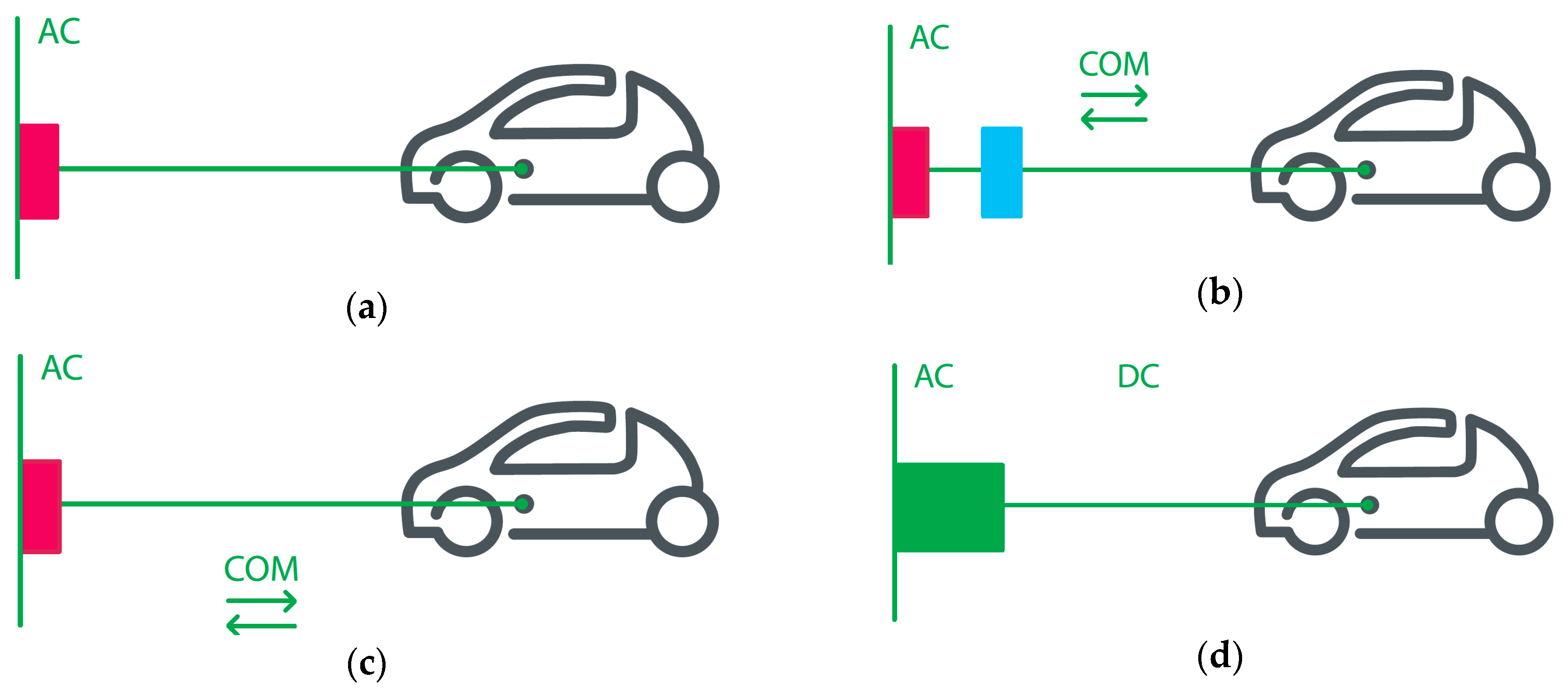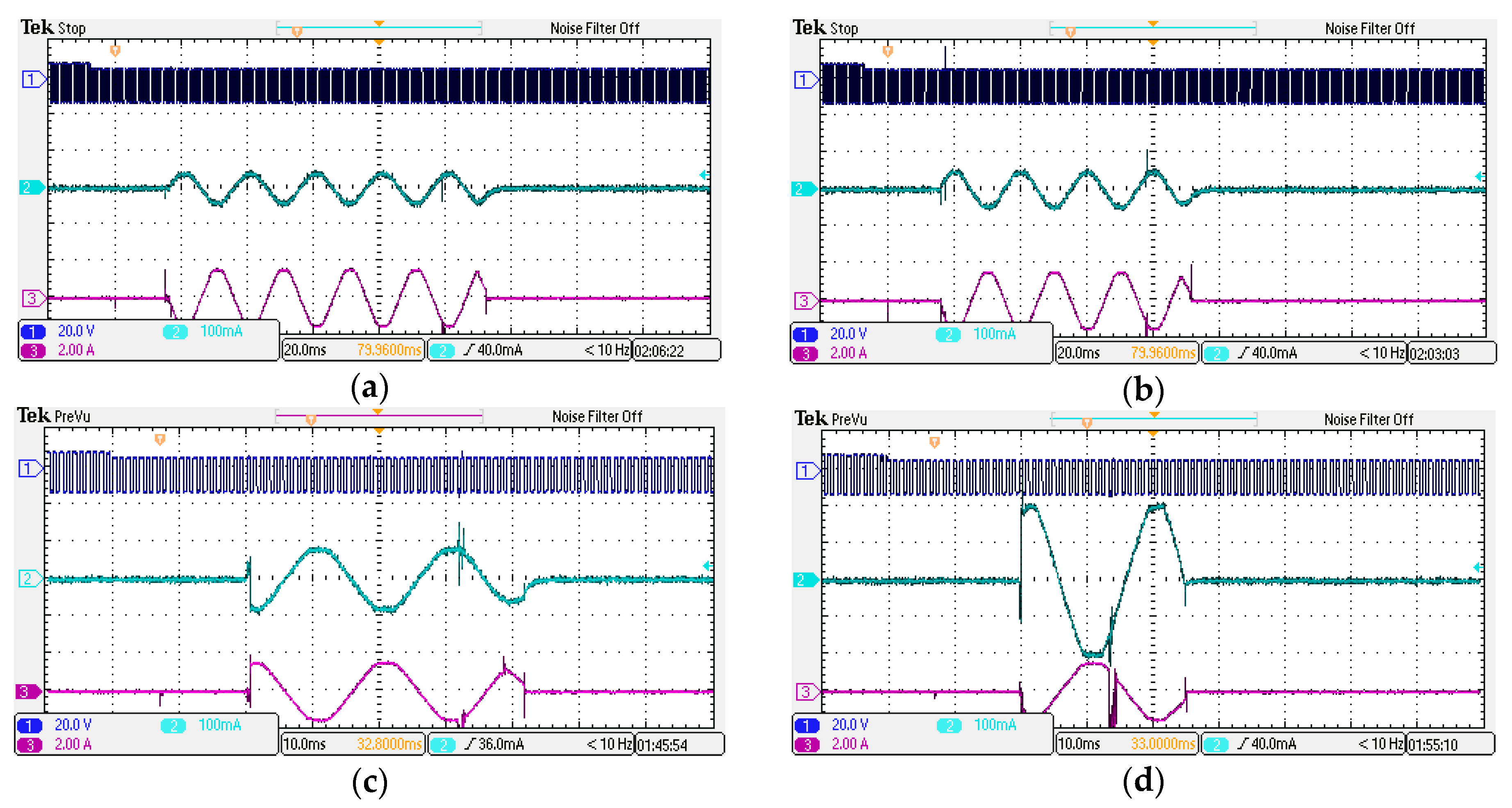The ElectricalVehicle Simulator for Charging Station in Mode 3 of IEC 61851-1 Standard
Abstract
:1. Introduction
2. IEC 61851-1 Standard
2.1. EV Charging Modes Defined in IEC 61851-1 Standard
- Mode 1 is the simplest solution for charging EV. In this case the EV is connected to the residences standard socket outlets but must have a circuit breaker for overload and earth leakage protections. In this mode the charging is realized without communication and it is rated up to 16 A.
- Mode 2 where the EV is connected to the domestic power grid via a particular cable with in-cable or in-plug control pilot and a protection device. The current must not exceed 32 A.
- Mode 3 where the EV is connected via specific socket on a dedicated charging station that has permanently installed the control and the protection functions. The rated charging current is up to 3 × 63 A.
- Mode 4, where the EV is fast charging in direct current (DC).
2.2. Charging Station in Mode 3 According to IEC 61851-1 Standard
- If the EV is correctly connected to the station;
- The maximum current capability of the cable assembly coded by a resistor. If the current is higher than this value, then the electric vehicle supply equipment (EVSE) interrupts the current supply. Most EVs are equipped with two cables one for slow charge (Mode 1) and other for fast charge (Mode 3);
- If the earthing system of the vehicle is connected correctly to EVSE.
- Vehicle unconnected, when the positive level of communication signal is 12 V;
- The cable assembly is plugged into both the EV and the EVSE, where the positive voltage level is 9 V;
- Vehicle is ready to receive energy, when S2 (Figure 2) is closed by the vehicle and the positive voltage level is 6 V.
3. Experimental Arrangement
4. Experimental Results
- The user can control the charging station via an easy HDMI interface;
- All parameters from a three-phase energy meter device (model EEM-350-D-MCB from Phoenix Contact) through MODBUS protocol using RS485 interfaces can be read;
- An identification code is used to recognize the authorized person which commands the starting and finishing of the charging process.
- This simulation is used to realize the periodic maintenance of Charging Station, from exploitation of the RCD relay;
- Verifying a correct functioning of the station controller;
- The solution for controlling the Charging Stations with PLC and HMI offers users the possibility to charge the EV without an RFID card, using a unique identification code chosen by driver [26].
5. Conclusions
- To create all charging stages for an EV to a charging station in mode 3 (EVSE) according to IEC 61851-1 standard and checks if the charging station works correctly;
- Permits measuring the charging station tripping time by generating different values of residual current.
Author Contributions
Acknowledgments
Conflicts of Interest
References
- United Nations Framework Convention on Climate Change (UNFCCC), Paris Agreement. Available online: https://unfccc.int/process-and-meetings/the-paris-agreement/the-paris-agreement (accessed on 28 August 2019).
- Hidrue, M.K.; Parsons, G.R.; Kempton, W.; Gardner, M.P. Willingness to pay for electric vehicles and their attributes. Resour. Energy Econ. 2011, 33, 686–705. [Google Scholar] [CrossRef] [Green Version]
- Yilmaz, M.; Krein, P.T. Review of battery charger topologies, charging power levels and infrastructure for plug-in electric and hybrid vehicles. IEEE Trans. Power Electron. 2013, 28, 2151–2169. [Google Scholar] [CrossRef]
- Fairley, P. Speed bumps ahead for electric-vehicle charging. IEEE Spectr. 2010, 47, 13–14. [Google Scholar] [CrossRef]
- Clement-Nyns, K.; Haesen, E.; Driesen, J. The impact of Charging plug-in hybrid electric vehicles on a residential distribution grid. IEEE Trans. Power Syst. 2010, 25, 371–380. [Google Scholar] [CrossRef] [Green Version]
- Yunus, K.; la Parra, H.Z.D.; Reza, M. Distribution Grid Impact of Plug-In Electric Vehicles Charging at Fast Charging Stations Using Stochastic Charging Model. In Proceedings of the 2011 14th European Conference on Power Electronics and Applications, Birmingham, UK, 30 August–1 September 2011; pp. 1–11. [Google Scholar]
- Botsford, C.; Szczepanek, A. Fast Charging vs. Slow Charging: Pros and cons for the New Age of Electric Vehicles. In Proceedings of the EVS24 International Battery, Hybrid and Fuel Cell Electric Vehicle Symposium, Stavanger, Norway, 13–16 May 2009. [Google Scholar]
- Gnann, T.; Funke, S.; Jakobsson, N.; Plotz, P.; Sprei, F.; Bennehag, A. Fast charging infrastructure for electric vehicles: Today’s situation and future needs. Transp. Res. Part D Transp. Environ. 2018, 62, 314–329. [Google Scholar] [CrossRef]
- Morrow, K.; Karner, D.; Francfort, J. Plug-in Hybrid Electric Vehicle Charging Infrastructure Review (U. S. Department of Energy Vehicle Technologies Program—Advanced Vehicle Testing Activity); Idaho National Laboratory (INL): Idaho Falls, ID, USA, 2008. [Google Scholar]
- Deb, S.; Tammi, K.; Kalita, K.; Mahanta, P. Review of recent trends in charging infrastructure planning for electric vehicles. Wiley Interdiscip. Rev. Energy Environ. 2018, 7, e306. [Google Scholar] [CrossRef] [Green Version]
- Răboacă, M.S.; Badea, G.; Enache, A.; Filote, C.; Răsoi, G.; Rata, M.; Lavric, A.; Felseghi, R.-A. Concentrating Solar Power Technologies. Energies 2019, 12, 1048. [Google Scholar] [CrossRef] [Green Version]
- Badea, G.; Felseghi, R.-A.; Varlam, M.; Filote, C.; Culcer, M.; Iliescu, M.; Răboacă, M.S. Design and Simulation of Romanian Solar Energy Charging Station for Electric Vehicles. Energies 2019, 12, 74. [Google Scholar] [CrossRef] [Green Version]
- Şişman, G.R.; Oproescu, M. Predictive maintenance of power industrial electronic equipment. J. Electr. Eng. Electron. Control Comput. Sci. 2015, 1, 21–30. Available online: https://jeeeccs.net/index.php/journal/article/view/18/10 (accessed on 1 December 2019).
- Ahn, N.; Jo, S.Y.; Kang, S.-J. Constraint-Aware Electricity Consumption Estimation for Prevention of Overload by Electric Vehicle Charging Station. Energies 2019, 12, 1000. [Google Scholar] [CrossRef] [Green Version]
- Chiper, A.M. The conception and execution of a simulation workbench for an automotive fuel gauge system. J. Electr. Eng. Electron. Control Comput. Sci. 2015, 1, 15–20. Available online: https://jeeeccs.net/index.php/journal/article/view/10/3 (accessed on 1 December 2019).
- Bizon, N.; Thounthong, P. Real-time strategies to optimize the fueling of the fuel cell hybrid power source: A review of issues, challenges and a new approach. Renew. Sust. Energy Rev. 2018, 91, 1089–1102. [Google Scholar] [CrossRef]
- Beleiu, H.G.; Beleiu, I.N.; Pavel, S.G.; Darab, C.P. Management of Power Quality Issues from an Economic Point of View. Sustainability 2018, 10, 2326. [Google Scholar] [CrossRef] [Green Version]
- Maier, V.; Pavel, S.G.; Beleiu, H.G.; Farcas, V. Additional Indicators for Short Time Overvoltages and Voltage Impulses. In Proceedings of the 2016 International Conference and Exposition on Electrical and Power Engineering (EPE), Iasi, Romania, 20–22 October 2016; pp. 827–831. [Google Scholar] [CrossRef]
- Rai, K.; Jandhyala, A.; Rai, S.C. Power Intelligence and Asset Monitoring for System. J. Electr. Eng. Electron. Control Comput. Sci. 2015, 1, 31–36. Available online: https://jeeeccs.net/index.php/journal/article/view/129/106 (accessed on 1 December 2019).
- Maier, V.; Pavel, S.G.; Beleiu, H.G.; Buda, C. Survey Regarding Additional Indicators for Voltage Sags. In Proceedings of the 2016 International Conference on Development and Application Systems (DAS), Suceava, Romania, 19–21 May 2016; pp. 103–107. [Google Scholar] [CrossRef]
- Liu, G.; Kang, L.; Luan, Z.; Qiu, J.; Zheng, F. Charging Station and Power Network Planning for Integrated Electric Vehicles (EVs). Energies 2019, 12, 2595. [Google Scholar] [CrossRef] [Green Version]
- Bizon, N.; Thounthong, P. Fuel economy using the global optimization of the Fuel Cell Hybrid Power Systems. Energy Convers. Manag. 2018, 173, 665–678. [Google Scholar] [CrossRef]
- Birleanu, F.G.; Bizon, N. Principles, Architectures and Challenges for Ensuring the Integrity, Internal Control and Security of Embedded Systems. J. Electr. Eng. Electron. Control Comput. Sci. 2015, 1, 37–45. Available online: https://jeeeccs.net/index.php/journal/article/view/68/60 (accessed on 1 December 2019).
- Deb, S.; Tammi, K.; Kalita, K.; Mahanta, P. Impact of Electric Vehicle Charging Station Load on Distribution Network. Energies 2018, 11, 178. [Google Scholar] [CrossRef] [Green Version]
- UEFISCDI. Project Number PN-III-P1-1.2-PCCDI-2017-0776/No. 36 PCCDI/15.03.2018, within PNCDI III, Grant from the Romanian Ministry of Research and Innovation, CCCDI. Available online: www.smile-ev.usv.ro (accessed on 28 August 2019).
- Shareef, H.; Islam, M.M.; Mohamed, A. A review of the stage-of-the-art charging technologies, placement methodologies and impacts of electric vehicles. Renew. Sustain. Energy Rev. 2016, 64, 403–420. [Google Scholar] [CrossRef]






| Stage | Switches | Description of the Stage | ||
|---|---|---|---|---|
| S1 (Figure 2) | S2 (Figure 2 and Figure 3) | S3 (Figure 3) | ||
| Figure 4a. Charging begin/end regime controlled by the electrical vehicle | ||||
| A | OFF | OFF | OFF | The vehicle is unconnected and the voltage measured by EVSE on pilot contact is +12 V DC |
| B | OFF | OFF | ON | EVSE is not ready. In this case the cable assemble is connected to EV and to the EVSE and the voltage measured by EVSE is +9 V DC. |
| C | ON | OFF | ON | EVSE is ready and at pilot contact is generated PWM signal (+9 V– −12 V). |
| D | ON | ON | ON | The vehicle is ready and charging process is active. In this case the positive voltage level of PWM signal is depending of R3 resistor value. If ventilation in charging area is not required, the R3 = 1.3 kΩ and the positive voltage value of PWM signal is 6 V (case illustrated in Figure 4a). If in the charging area the ventilation is required, the R3 = 270 Ω the positive voltage value of PWM signal is 3 V. |
| E | OFF | ON | ON | The vehicle is not ready and charging process is aborted. |
| F | OFF | OFF | ON | EVSE is not ready. |
| G | OFF | OFF | OFF | The vehicle is unconnected. |
| Figure 4b. Charging begin/end regime controlled by the station (EVSE) | ||||
| A | OFF | OFF | OFF | The vehicle is unconnected and the voltage measured by EVSE on pilot contact is +12 V DC |
| B | OFF | OFF | ON | EVSE is not ready. In this case the cable assemble is connected to EV and to the EVSE and the voltage measured by EVSE is +9 V DC. |
| C | OFF | ON | ON | The vehicle is ready and at pilot contact is measured 6 V DC. |
| D | ON | ON | ON | The EVSE is ready and charging process is active. In this case at pilot contact is generated PWM signal. |
| E | OFF | ON | ON | The EVSE is not ready and charging process is aborted. In this case when S1 switches OFF the charging process continues for about 3 seconds |
| F | OFF | OFF | ON | EV is not ready. |
| G | OFF | OFF | OFF | The vehicle is unconnected. |
© 2019 by the authors. Licensee MDPI, Basel, Switzerland. This article is an open access article distributed under the terms and conditions of the Creative Commons Attribution (CC BY) license (http://creativecommons.org/licenses/by/4.0/).
Share and Cite
Rata, M.; Rata, G.; Filote, C.; Raboaca, M.S.; Graur, A.; Afanasov, C.; Felseghi, A.-R. The ElectricalVehicle Simulator for Charging Station in Mode 3 of IEC 61851-1 Standard. Energies 2020, 13, 176. https://doi.org/10.3390/en13010176
Rata M, Rata G, Filote C, Raboaca MS, Graur A, Afanasov C, Felseghi A-R. The ElectricalVehicle Simulator for Charging Station in Mode 3 of IEC 61851-1 Standard. Energies. 2020; 13(1):176. https://doi.org/10.3390/en13010176
Chicago/Turabian StyleRata, Mihai, Gabriela Rata, Constantin Filote, Maria Simona Raboaca, Adrian Graur, Ciprian Afanasov, and Andreea-Raluca Felseghi. 2020. "The ElectricalVehicle Simulator for Charging Station in Mode 3 of IEC 61851-1 Standard" Energies 13, no. 1: 176. https://doi.org/10.3390/en13010176
APA StyleRata, M., Rata, G., Filote, C., Raboaca, M. S., Graur, A., Afanasov, C., & Felseghi, A.-R. (2020). The ElectricalVehicle Simulator for Charging Station in Mode 3 of IEC 61851-1 Standard. Energies, 13(1), 176. https://doi.org/10.3390/en13010176








